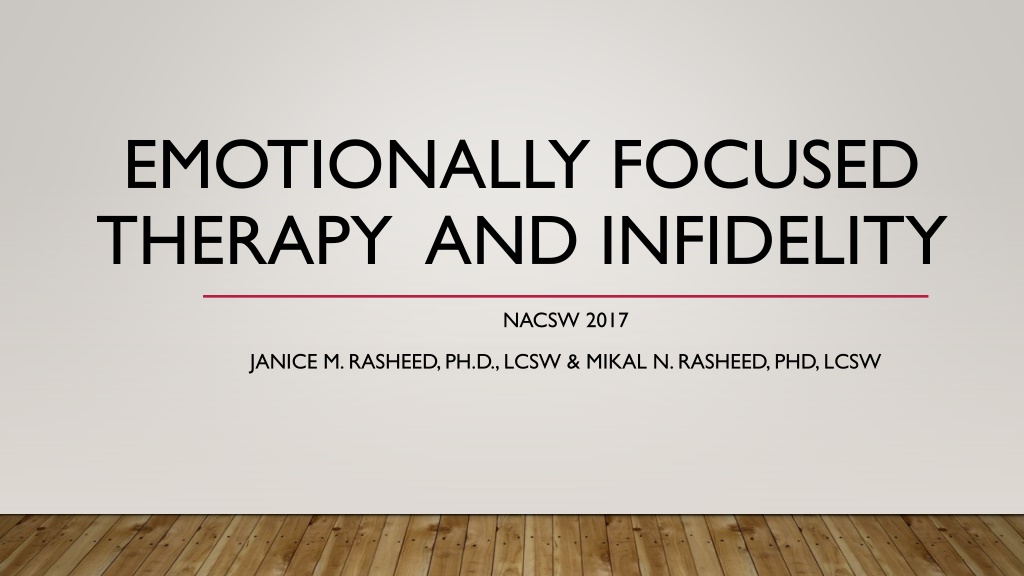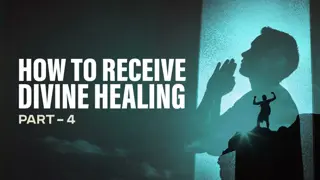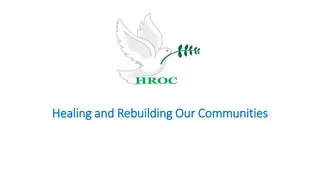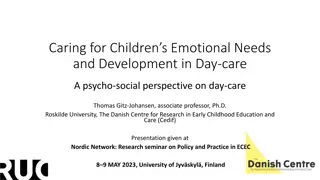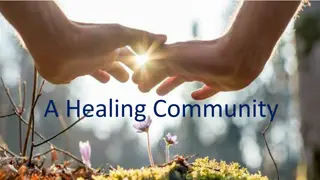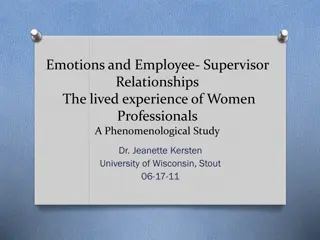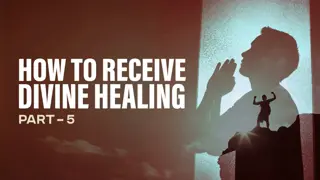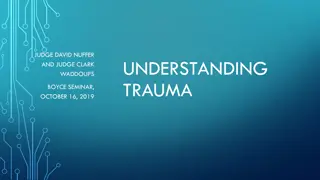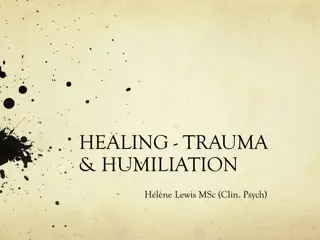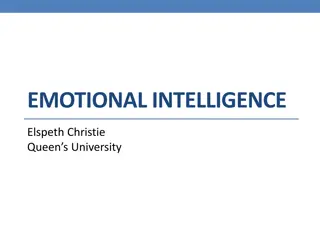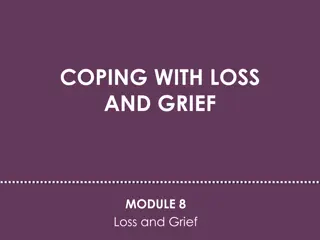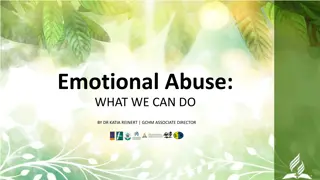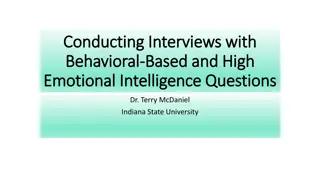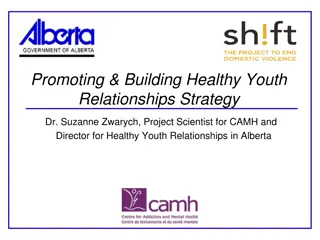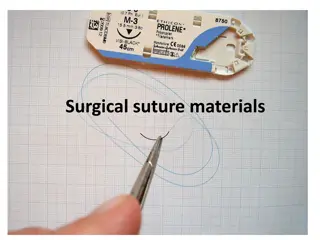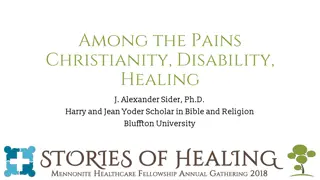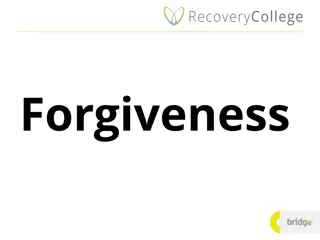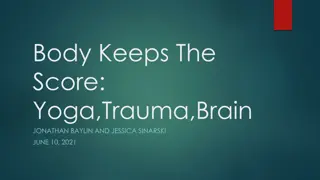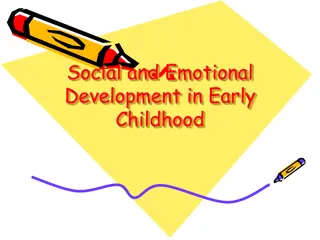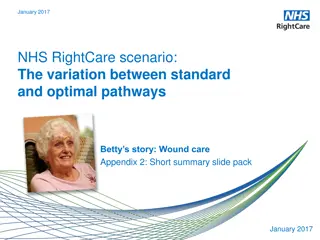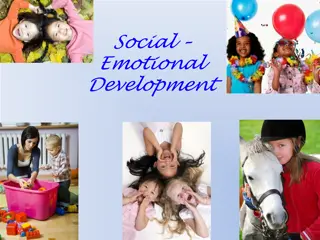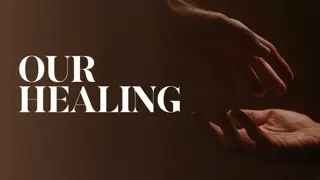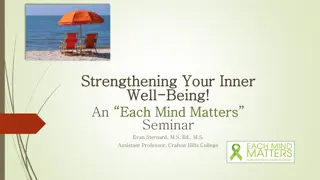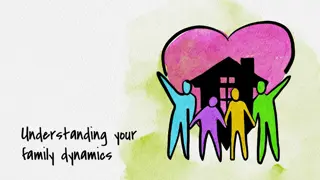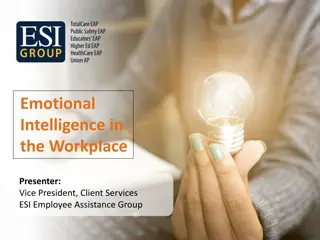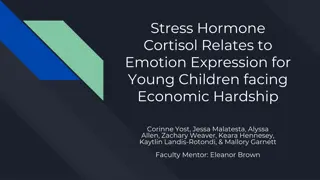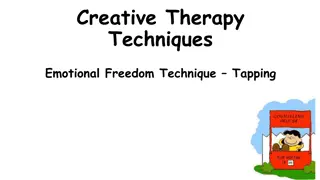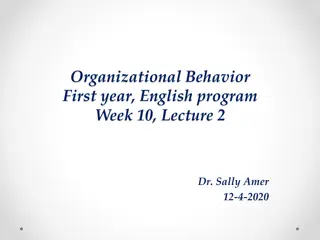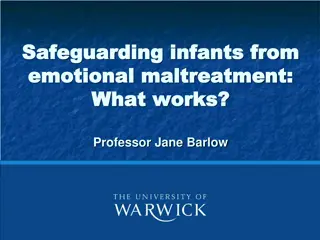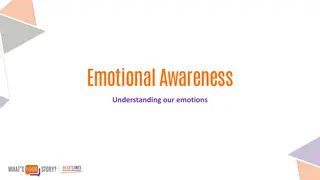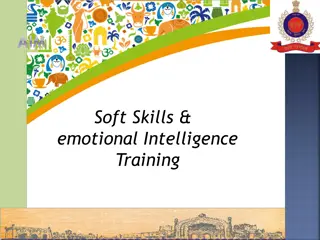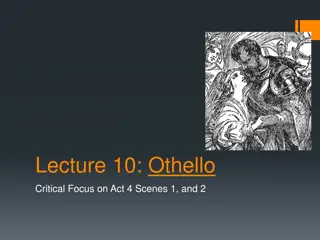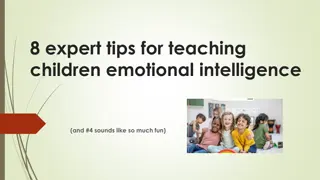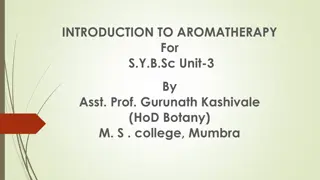Understanding Infidelity and Emotional Healing in Relationships
Explore the emotional impacts of infidelity on relationships, with insights into the signs of hurting marriages, data on infidelity statistics, what constitutes an affair, and reasons why affairs happen. Discover the importance of addressing unresolved needs, societal influences, and the role of communication in relationship healing.
Download Presentation

Please find below an Image/Link to download the presentation.
The content on the website is provided AS IS for your information and personal use only. It may not be sold, licensed, or shared on other websites without obtaining consent from the author. Download presentation by click this link. If you encounter any issues during the download, it is possible that the publisher has removed the file from their server.
E N D
Presentation Transcript
EMOTIONALLY FOCUSED THERAPY AND INFIDELITY NACSW 2017 JANICE M. RASHEED, PH.D., LCSW & MIKAL N. RASHEED, PHD, LCSW
HURTING FAMILIES Hurting marriages may have spouses who control rather than empower their partner and lack confidence that they can influence the other in an affirming and validating manner. Hurting marriages are those in which the spouses are not in touch with feelings-need a safe atmosphere in which they can express their feelings- need for open communication
DATA ON INFIDELITY Infidelity statistics research conducted: Sept. 7, 2016: Journal of Marital & Family Therapy *Percent of marriages where one or both spouses admit to infidelity, either physical or emotional = 41 % *Marriages that last after an affair has been admitted to or discovered = 31 %
WHAT CONSTITUTES AN AFFAIR? * Any relationship or friendship that is kept secret from the spouse [which includes social media (Internet) relationships ] * Any sharing of emotions OR physical intimacy in a relationship in which the spouse is not included * Pornography * Hiring of prostitutes or escorts * Book: "Just Friends"-concept of 'walls and windows' - (of intimacy). Wall around the couple's relationship and window of intimacy that can be opened w/ "just friends"
WHY DO AFFAIRS HAPPEN? * affairs happen because the unfaithful spouse hasn't faced what they really need to do about the marriage * The unfaithful spouse Uses their unresolved needs to justify their behavior * curiosity; boredom; desire to escape something; need attention & affirmation=all his/her own emotional issues why infidelity happens & society's declining morality re infidelity * Secrecy & lies are the foundation of affairs * Avoid (implicitly) blaming the betrayed spouse via exploration of WHAT HAPPENED IN THE MARRIAGE TO LEAD TO THE AFFAIR (doesn't mean marriage doesn't need to change, but this is not WHY AFFAIR happened) WHO * Affairs also happen in good marriages
WHAT HAPPENS IN THE AFFAIR? * Affairs are a device that medicate. They become a drug and you get in a fog and loose your focus. "The affair happens BEFORE the affair happens." There is a slow fad in their thinking that deteriorates your thinking & judgment. You convince yourself that it's not so bad what you're going to do. One client described it as if they were swirling around in a toilet knowing she was eventually going to be flushed down the toilet bowl. * The affair serves as a "Fun house mirror" that reflects what unfaithful partner wants to believe about themselves (warn them not to try to 'compete' with the affair partner-it can become an obsession.) Remind them that your spouses' affair partner is the symptom-not the cure for what's wrong with the unfaithful spouse.
HOW IT IMPACTS THE COUPLE? Betrayed partner * The pain is so deep because the marriage is our safe place in the world. The betrayed partner focus on themselves. Let them know they will be GREAT AGAIN -one day!!' * Emotions=Denial, shock, Anger/rage, self doubt/self blame, jealousy, sadness, disappointment, mourning * PIST-Post Infidelity Stress Trauma-Triggers; hypervigilance -Even after 10 years post affair she sees she has changed re how loose she was regarding knowing her husband's whereabouts. She wasn't as vigilant as immediately after the discovery of the affair-but not as "loose" as she was before she discovered his affair.
HOW IT IMPACTS THE COUPLE? Unfaithful partner * Guilt; denial="trickle truth"-explain; sadness (possible loss of excitement of affair or of partner & hurting spouse); anger and resentment @ spouse=wanting betrayed partner to hurry up and move on & reluctance to discuss Affair; anger @ self, confusion (how could have allowed affair to happen-self doubt & feelings loss of integrity);
WHAT TO DO-AFTER D-DAY (DISCOVERY DAY) * some therapists recommend that you find a "marriage friendly" therapist-i.e. A therapist that supports marriage and doesn't feel that an affair doesn't necessarily mean the end of the marriage * Tell betrayed partner so they can stop blaming themselves for their partners affair * The betrayed partner doesn't just get over it-They get thru it
WHAT TO DO-AFTER D-DAY (DISCOVERY DAY) * Post affair Healing is a PROCESS. It's like a death of something. You're always going to miss how you saw your marriage before the Affair. You're never going to be the same person as before the affair- and you're never going to see your spouse as you did before. But one day you're be better. Watch the numbing behaviors (shopping too much, eating or drinking too much) as you need to feel the pain. You don't need to forget what happened to heal. * Every day is not a good day- you will have good & bad days. But this doesn't mean that you're not progressing and healing. * One client reports she fell in love with her spouse again admiring watching him work so hard to become a better person and watch him work to change and become a better husband. (Although She took no responsibility for his cheating.)
HOW TO AVOID AFFAIRS? * Affairs are prevented when you tell the truth about things that are important in the marriage that concern you * The Secret to monogamy is a commitment to honesty & openness with your spouse
THEORETICAL ASSUMPTIONS The need to attach to a significant other is hard wired in humans. Genesis 1 tells us we are made in God s image. We serve a relational God. You did not choose me but I chose you. John 15:14-16 I Corinthians 12, reminds us of that God designed us to be connected to a group-- the Body of Christ.
BACKGROUND OF EFT APPROACH Developed by Johnson and Greenberg (1985) A psychodynamic approach Rooted in attachment theory (Bowlby 1969) Focus is on emotional attachment Help couple restructure and expand their emotional responses to each other (restructure their interactional dance ) Create a more secure (emotional) bond Empirically based
DEFINITION/ THEORETICAL ASSUMPTIONS Is a process in which the therapist is a consultant who supports partners in restructuring and expanding their emotional responses to each other Emotions are identified and expressed in a way to help partners move into new stances in their relationship (promotes secure bonding) Focuses on reshaping distressed couple s repetitive interactional patterns and the emotional responses that evoke these patterns Postmodern influences (Challenges how couples construct their inner and outer realities) Embrace the concept of circular causality (how couples create interactive patterns using feedback loops)
DEFINITION/ THEORETICAL ASSUMPTIONS Unhealthy (or problematic) interactions are characterized by rigid and a constricted range of responses (vs flexible and responsive to needs of partners) Non pathologizing/No attempt to assign blame, just new ways to interact Holistic (integrates inner/outer intrapsychic and interpersonal into a whole) Attachment needs and desires are essentially healthy and adaptive (It is way needs are enacted in a context perceived insecurity creates the problem) Change occurs not through insight into the past, catharsis, or by negotiation but through new emotional experience in the present context of attachment in relationship
STAGE ONE: CYCLE DE-ESCALATION Step 1. Identify relational conflict issues Step 2. Identify negative cycle (where issues are expressed) Step 3. Access the unacknowledged emotions underlying emotions and attachment needs Step 4. Reframe the problem (in terms of the cycle underlying emotions that accompany it and attachment needs)
STAGE TWO: CHANGING INTERACTIONAL POSITIONS Step 5. Promote each partner s identification with disowned attachment needs and aspects of self (may include need for reassurance and comfort aspects of self that are not identified may include a sense of shame or unworthiness Step 6. Promote acceptance of each partner by the partner s experience Step 7. Facilitate the expression of needs and wants to restructure the interaction based on new understanding and create bonding events
STAGE THREE: CONSOLIDATION AND INTEGRATION Step 8. Facilitate the emergence of new solutions to old problems Step 9. Consolidate new positions and cycles of attachment behavior
Ultimate goal of therapy is the creation of new cycles of secure bonding that offers an antidote to negative cycles and redefine the nature of the relationship)
THREE TASKS 1. Create a safe collaboration (therapeutic) alliance 2. Access and expand the emotional response that guide couples interaction 3. Restructure interactions in the direction of accessibility and responsiveness
ALLIANCE BUILDING AND ENGAGEMENT The cycle becomes the villain not each other and the need for blame is neutralized Search for and validate strengths of the relationship Therapist is active and directs partners disclosures toward attachment-salient interactions, attributions and emotional responses Creation of alliance in EFT is based on the techniques of humanistic-experiential therapies (i.e., empathic attunement, acceptance, and genuineness, etc.) Allow each couple to dictate the goal, pace and form of change (the client sets the frame, but the couple paint the picture)
ONCE THE ALLIANCE IS ESTABLISHED, THERE ARE TWO BASIC THERAPEUTIC TASKS IN EFT: 1. The exploration and reformulation of emotional experiences Reflecting emotional experience (main functions: focusing the therapy process; building and maintaining the alliances; clarifying emotional responses underlying interactions.) Validation (main functions: legitimizing responses and supporting clients to continue to explore how they construct their experience and their interactions; building alliance.) Evocative responding: expanding e.g.: what s happening right now as you say that , (main functions: formulating unclear or marginalized elements of experience and encourage exploration and engagement.) Heightening: using repetition, images, metaphors, or enactments Empathic conjecture or interpretation: (main functions: clarifying and formulations new meanings, especially regarding interactional positions and definitions of self.)
2. THE RESTRUCTURING OF INTERACTIONS Restructuring and shaping interactions: enactment present positions, enacting new behaviors based upon new emotional experiences, and choreographing specific change events. (Main functions: clarifies and expands negative interaction patterns, creates new kinds of dialogue and new interactional steps/positions, leading to positive cycles of accessibility and responsiveness.)
COMMON THERAPEUTIC IMPASSES Most common place is when therapist attempts to shape positive interactions to foster secure bonding therapist affirms the difficulty of learning to trust, and remains hopeful and engaged in despite temporary reoccurrence of distress Individual sessions with each partner to explore the impasse and soothe the fears associated with new levels of emotional engagement New emotions frequently emerge and the betrayed/injured spouse may stay in touch with the injury (the affair) and attachment significance. The partner can begin to hear and understand the significance of the injurious event and understand it in attachment terms (and not as a reflections of personal inadequacies.)
COMMON THERAPEUTIC IMPASSES Betrayed/injured partner can move toward a more integrated and complete articulation of the injury Partner can become more emotionally engaged and acknowledges responsibility for his/her part in the attachment injury and express empathy, regret and/or remorse Injured/betrayed spouse then risks asking for the comfort and caring from his/her mate that was previously unavailable however the mate can respond in a caring way that acts as an antidote to the attachment jury Facilitate the (unfaithful) to be able to develop a clear sense of how he/she came to respond to the betrayed/injured partner during the affair
MECHANISMS OF CHANGE Now the accessible spouse is able to make requests and both become more mutually responsive and bonding interactions can occur ..called a softening of the partners
LEVELS OF CHANGE IN A SOFTENING: An expansion of experience that includes accessing attachment fears and the longing for comfort and contact An engagement of the partner in a different way frightened partner puts emotional needs into words and changes part of the dance new emotions/dances emerge (Betrayed) Spouse sees partner in a different light as afraid rather than dangerous, and is pulled toward his/her by expressions of partners vulnerability
LEVELS OF CHANGE IN A SOFTENING: New cycle is initiated. S/her reaches for comfort and the new connection offers an antidote to negative interactions and redefines the relationship as a secure bond A bonding event occurs in the session. This bond then allows for open communication, flexible problem solving, and resilient coping with everyday issues There are shifts in both partners sense of self. Both can comfort and be comforted and defined as lovable and entitled to care in the interaction
